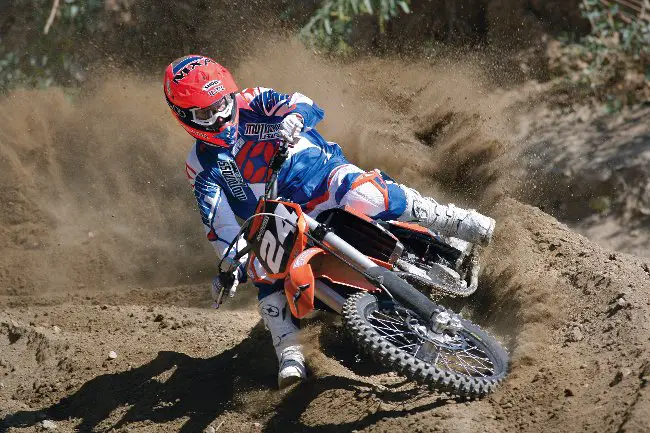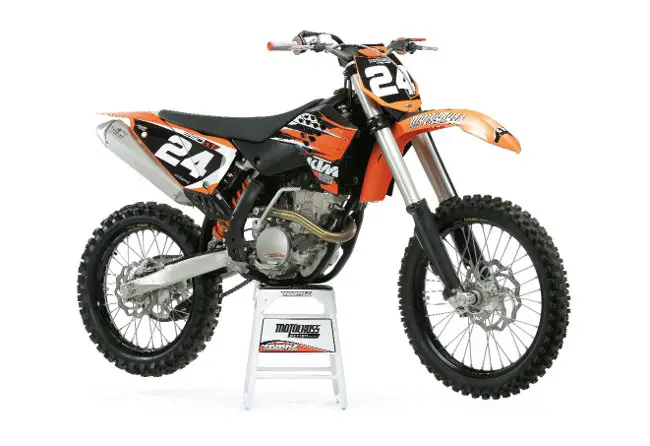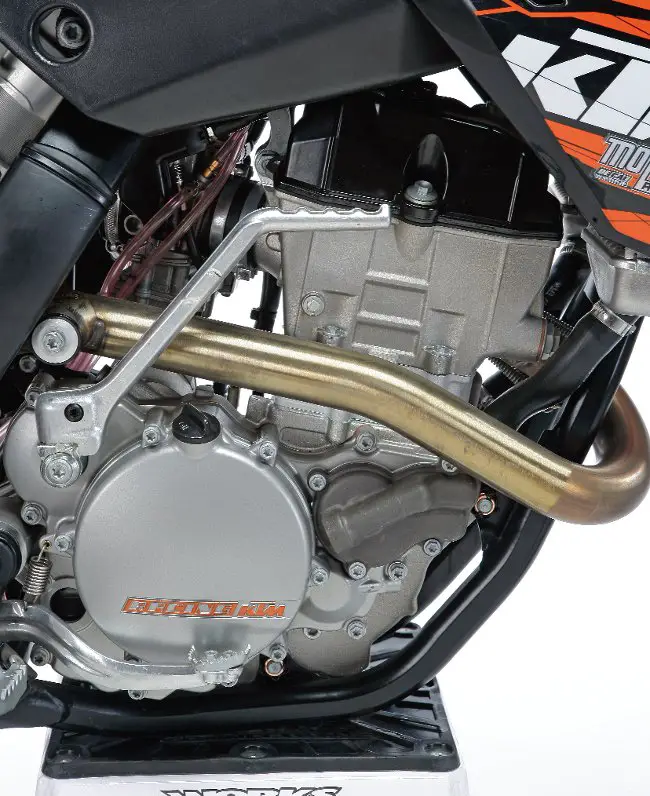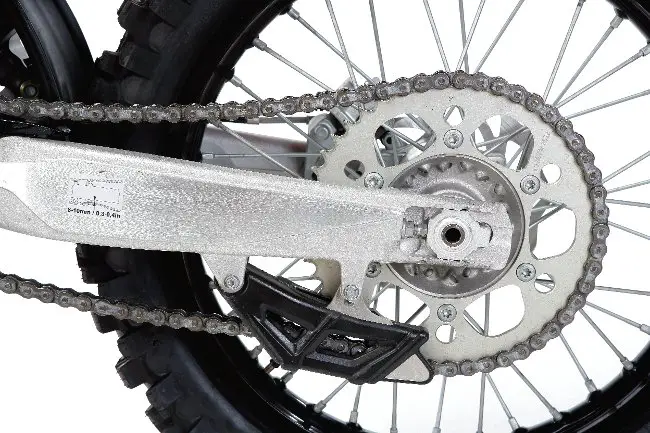REAL TESTS! 2010 MXA RACE TEST OF THE KTM 250SXF:

Q: FIRST AND FOREMOST, IS THE 2010 KTM 250SXF BETTER THAN THE 2009 KTM 250SXF?
A: Yes, but not night-and-day better.
Q: IS THE 2010 KTM 250SXF FASTER THAN THE 2009 KTM 250SXF?
A: No. On the track, the 2009 model is marginally better than the 2010 KTM 250SXF. In recent years, KTM has established itself as an engine powerhouse. Horsepower is KTM’s modus operandi, but that trend changed slightly for 2010. What happened? Sound, and its effect on riding areas. With tighter sound restrictions being placed on motorcycle manufacturers, KTM sought a solution for their 250SXF that would meet the increasingly quiet European sound restrictions. They found an answer in the 250SXF’s offroad brother, the 250XC-F. The longer muffler from the offroad bike, coupled with a consistently small core in the muffler, reduces the sound level to an amazing 92 dB.
Q: WHAT CHANGES DID KTM MAKE TO THE 250SXF FOR 2010?
A: KTM doesn’t make snap decisions. They make minimal changes every year to their bikes, as opposed to throwing away tried-and-true machinery for something altogether different. Refinement is the mantra by which KTM lives. The MXA wrecking crew likes that the Austrian company focuses on improving an existing product as opposed to gambling on the next unproved idea.
We counted 18 changes made to the 2010 KTM 250SXF. Most of these updates were incorporated into KTM’s entire motocross line (including two-strokes).
(1) Engine. The engine received harder piston rings that are extremely durable. The ignition box has a new program for a slightly different curve at lower rpm (for sound testing). There is also a new part number on the cylinder head due to a casting change. However, this change doesn’t affect the performance of the engine. A boss was put into the head for a different vacuum pickup on the intake port (for European emissions standards).
(2) Triple clamps. Gone are the adjustable offset triple clamps. Last year, the 250SXF had 18mm and 20mm offset options with four-mount bar positioning. For 2010, the triple clamps are fixed at 22mm but still retain the four-mount bar positioning. The lower clamp has a twin-bolt design instead of the previous three bolts. The steering stem is also tapered for improved flex.
(3) Airbox. The modified airbox improves air filter protection, thanks to a molded-in lip that keeps water from splashing onto the filter. The 250SXF will also use a new Twin Air filter, but the older filters still fit.
(4) Suspension. The WP forks have new seals and bushings to reduce sliding friction. The fork and shock valving have been increased for more comfort and better bottoming resistance. KTM also lowered the fork oil height by 20cc because they stiffened the valving. Over the past three years, KTM has lowered the oil height in their forks by 25cc. That’s quite a bit of fluid.
(5) Brakes. For the second year in a row, KTM changed the compound of their brake pads. In an effort to make the brakes more progressive than last year, the 250SXF receives Toyo B153 brake pads. These brakes are said to provide a more consistent feel.
(6) Cosmetics. Clean linear lines have replaced the ransom note cartoon graphics on the 250SXF. Although not new, KTM still uses inmold technology to embed their graphics into the shrouds. The 2010 250SXF also receives Renthal, diamond-pattern, dual-compound grips.

Grateful public: The best thing that KTM did for 2010 was getting rid of the atrocious ransom note graphics from last year.
Q: HOW FAST IS THE 2010 KTM 250SXF?
A: This will sound confusing, but the 250SXF is both a slow and a fast bike. Has the MXA wrecking crew gone crazy? No. The 2010 KTM 250SXF has tons of power, but it’s hard for many riders to feel the tremendous power that the engine produces. On the track, the 250SXF powerplant comes on slowly. It builds steadily through the midrange and reaches warp speed in the top end.It doesn’rt really have a distinct powerband like the RM-Z250, KX250F, YZ250F or CRF250. The power delivery is very linear (it just builds and builds and builds until it signs off).
Last year, KTM shaved weight off many of the engine’s moving parts, which drastically helped low-end pickup (the 2008 250SXF engine was anemic). The 2010 250SXF isn’t really any different from the previous model on paper, and it doesn’t feel any different on the track. That is not a negative statement, considering we had this to say about its predecessor: “The 2009 engine doesn’t give up the ghost until well into the top-end and has plentiful over-rev.”
The 2010 KTM 250SXF has a beast of an engine. It won’t grunt off the bottom, but once it reaches the midrange (8000 to 10,000 rpm) the engine turns violent. As for top-end power, the 250SXF has no equal. The 250SXF actually makes its peak horsepower after its competitors have signed off.
Q: HOW DOES THE 2010 KTM 250SXF ENGINE COMPARE TO THE 2009 KTM 250SXF ON THE DYNO?
A: There’s proof in the pudding that lengthening a muffler drastically affects maximum horsepower. By using the 250XC-F muffler on the 250SXF to decrease sound, they effectively choked up the engine. The 2009 model pumped out 38.6 horsepower at 12,800 rpm. For 2010, the KTM 250SXF produces 36.9 horsepower at 12,200 rpm.
Although down nearly two horsepower from last year’s engine, the 2010 powerplant produces nearly a horsepower more than any other 2010 from 12,000 rpm on. And if you want even more power, replace the stock 2010 muffler with last year’s muffler (or any aftermarket slip-on).
Q: WHAT WOULD BENEFIT THE 2010 KTM 250SXF ENGINE THE MOST?
(1) Forks. It’s nice to see that KTM knows they have a problem with their WP forks. How do we know that KTM is aware of the problem, aside from our incessant complaining? KTM lowered the fork oil height by 20cc. The decreased oil level is supposed to reduce midstroke harshness. It’s a step in the right direction, but the forks are still too harsh. We removed an additional 15cc of oil from each fork leg and found immediate relief (but not perfection).

To the moon Alice: If you are a revver, the 250SXF is for you.
(2) Gearing. Dear KTM, for 2011, please assume that everyone who owns a 250SXF won’t be racing the GP circuit. On American motocross tracks, with tight and often technical sections, the 250SXF needs at least one extra tooth on the rear sprocket. The 48-tooth rear is best suited to extremely fast tracks and drag strips. Every MXA test rider complained about the tall gearing. We switched to a 49-tooth sprocket to close the gaps between second, third and fourth gears. Slower riders, or those riding extremely tight tracks, might even swap the stock gearing for a 50-tooth sprocket.
(3) Exhaust. KTM equipped the 250SXF with the 250 XC-F muffler. It lowers the sound level, but hampers maximum horsepower and over-rev. We felt the need to swap out the stock exhaust system for an aftermarket system. The good news is that your aftermarket exhaust from last year will work on the 2010 model. Just beware that the stock pipe’s one-piece design makes the head pipe nearly impossible to remove without first removing the bottom shock bolt and rotating the shock up.
(4) Punch. American riders like midrange punch. KTM would be a better all-around bike if the powerband was less linear.
Q: HOW IS THE JETTING?
A: Initially, there was a hesitation off the bottom, most noticeably after the engine warmed up. We found that the 2010 KTM 250SXF was too rich off the bottom, so we made changes to the pilot jet, needle clip position and fuel screw. We also made a change to the accelerator pump screw. The 39mm Keihin FCR carburetor comes with a leak jet for fine-tuning.
MXA’s recommended jetting is as follows (stock settings are in parenthesis):
Main: 175
Pilot: 38 (40)
Needle: OBEKP
Clip position: Third from top (Fourth from top)
Fuel screw: 1-1/2 turns out (1-1/4 turns out)
Leak jet: 50
Notes: On the accelerator pump, we turned the screw in until it made contact with the pump and then backed it out 1/4 of a turn. From the contact point, back the adjustment screw out (counting turns as you go). This is a must-do adjustment.
Q: HOW WELL DO THE WP USD FORKS WORK?
A: The White Power (WP) USD forks are stiff and harsh in the midstroke. Just as in years past, we played with the fork oil height to help eradicate the discomfort.
The MXA wrecking crew learned a handy technique years ago for removing oil from the fork legs. Simply remove the forks from the bike, unscrew the air bleed screw on top of the fork, and pump the fork leg continuously over a measuring cup. Oil will exit out the air bleed screw hole.
We drained oil out of the forks in increments of 10cc until the forks bottomed, and then we added 5cc back into the legs through the air bleed screw hole with a hypodermic needle. Settling on a 15cc lower oil height (350cc) allows the bottoming cones to do their job as the forks begin to use their full travel. Once the proper oil height is achieved, the 48mm WP forks work fairly well (although not as well as some of the other offerings from the competition?or even other KTMs).
Q: WHAT ARE MXA’S RECOMMENDED KTM 250SXF FORK SETTINGS?
A: Here is what the MXA wrecking crew ran in its 2010 KTM 250SXF. Stock settings are in parenthesis:
Spring rate: 0.46 kg/mm
Oil height: 350cc (365cc)
Compression: 10 clicks out (12 clicks out)
Rebound: 11 clicks out (12 clicks out)
Fork leg height: 5mm up
Notes: When the forks are new, they need about an hour of riding to break in. Smaller riders might opt to lower the oil height by 20cc (from stock).
Q: WHO DID KTM TARGET WITH THEIR WP SHOCK?
A: KTM is a racing company. They understand that KTM riders are a special breed of individuals who like to stand out from the crowd. The no-link suspension is an obvious difference from the motocross bikes that the Japanese manufacturers produce. And in spite of popular opinion that no-link suspension doesn’t work, most MXA test riders like the WP no-link suspension that comes on KTM’s motocross bikes. The 250SXF is no different. With a modicum of changes to the rebound and compression, the 250SXF shock works fairly well. Lighter riders will find the standard 6.9 kg/mm shock spring too stiff for their tastes. KTM used spring rates that complement faster and heavier riders. Those weighing less than 160 pounds should opt for a 6.6 kg/mm spring.
Q: WHAT IS MXA’S RECOMMENDED KTM 250SXF SHOCK SETTING?
Spring rate: 6.9 kg/mm
Race sag: 110mm
Hi-compression: 1-1/4 turns out (1-1/2 turn out)
Lo-compression: 12 clicks out (15 clicks out)
Rebound: 25 clicks out (24 clicks out)
Notes: KTM recommends running between 105 and 110mm of race sag to maximize the shock’s potential. Also, if you need to go further than 26 clicks out on rebound, then it’s best to switch to a 6.6 kg/mm shock spring.

Six-speed: The cheapest hop-up is a bigger rear sprocket.
Q: HOW DOES THE 2010 KTM 250SXF HANDLE?
A: In stock trim, the 250SXF handles like a bucking bronco?thanks to the forks. On rough tracks, the bike refuses to go in a straight line. The WP forks deflect off bumps, the front end shakes violently, and every bump feels like it could be the last of your life. Unless you’re a masochist, the stock suspension setup is unpleasant. After lowering the fork oil height by 15cc and working with the shock sag, we noticed an immediate improvement in both ends. In previous years, we complained about the shock and its tendency to step out when the bike was unloaded. Although we did notice this trait at various times through testing, we never encountered the massive problems that we had in the past. We believe that this is due to the updated shock valving specs.
Once the fork malady is resolved, the 2010 KTM 250SXF handling substantially improves. The 250SXF does its best work around fast outside corners as opposed to tight inside lines. However, don’t be afraid to take unconventional lines on a whim, because the 250SXF quickly responds to rider input. Test riders felt that straight-line stability was quite good once the suspension was dialed in for their weight and skill level.
Q: WHAT DID WE HATE?
A: The hate list:
(1) Forks. We’re getting tired of draining oil out of the WP USD forks in order to get them to work properly. For 2011, we hope that KTM banishes the dreaded midstroke harshness.
(2) Muffler. We like quiet bikes, but we don’t want to give up horsepower to get it. Swap out the stock XC-F muffler for an aftermarket exhaust system.
(3) Gearing. KTM should equip 250SXF models that are sold in America with 49-tooth rear sprockets. Why? Americans don’t ride on tracks that mirror drag strips.
(4) Lifting. Unless you know a magic levitation spell, it’s not easy to lift the 250SXF on or off a bike stand. We hand-cut the right side panel to give access to the frame rails..
Q: WHAT DID WE LIKE?
A: The like list:
(1) Engine. It lacks substantial hit off the bottom, but the engine is powerful from the midrange on up (and especially spicy in the top-end). Gearing the bike down dramatically livens up the engine.
(2) Front brake. If you prefer the powerful brakes of past years, just put in the 2010 brake pads from the KTM 450SXF. The new Toyo pads aren’t as grabby, but KTM brakes are still the strongest in the class. Test riders could go deep into a corner and still make the turn. As Borat would say, “Very nice!”
(3) Hydraulic clutch. The Brembo unit has a smooth, fluid feeling. What’s not to like about it?
(4) Tires. As the MXA wrecking crew grows another year older, the sneakers on the KTM 250SXF remain the same. For 2010, KTM stuck with Bridgestone’s M59/M70 tire combination. They are oldies but goodies, especially in soft-to-intermediate terrain.
(5) Graphics. Apparently, the squeaky wheel gets the grease. Last year we complained endlessly about the ugly graphics on the 2009 KTM 250SXF. KTM must have listened, because the 2010 model has an excellent graphics scheme.
Q: WHAT DO WE REALLY THINK?
A: Coming to terms with the 2010 KTM 250SXF is like following a Nora Roberts romance novel. A romance is sparked, followed by a myriad of setbacks, until love is once again restored. Our 2010 250SXF was a solid race package that was in need of different gearing, a new exhaust system and less oil in the forks. Once those three issues were solved, we learned to love the 2010 KTM 250SXF for what it is?-a high rpm rocket ship that loves to be revved.





Comments are closed.